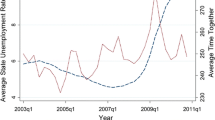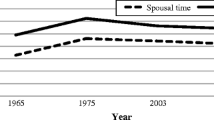Abstract
Using 2008 China Time Use Survey data, this paper provides empirical evidence on whether and how Chinese couples synchronize their time use. The main findings are: (1) Chinese couples do deliberately coordinate their time use to gain more synchronous time in household work and leisure. (2) Non-couples also synchronize their activities if they live in the same household, but their time synchronization is much weaker than that of couples. (3) Couples’ synchronous time is significantly correlated to the husband’s and the wife’s labor supply and job characteristics, including wage rates, employment status, and occupation, as well as other personal characteristics and household demographics. This correlation differs between urban and rural couples. Generally speaking, urban couples are more similar to their Western counterparts. This paper is the first to provide a profile of couples’ coordination of time allocation in the socioeconomic context of a developing country, and it deepens the understanding of couples’ joint time allocation.



Similar content being viewed by others
Notes
For a detailed description of the 2008 CTUS, please refer to Dong and An (2014).
Non-couple household members refer to all possible pairs of household members who live in the same household but are not couples.
Mansour and McKinnish (2014) find that the presence of children reduces time spent with a spouse in household production. Again, time with a spouse is different from synchronous time.
References
Barnet-Verzat, C., Pailhe, A., & Solaz, A. (2011). Spending time together: The impact of children on couples’ leisure synchronization. Review of Economics of the Household, 9(4), 465–486.
Bryan, M. L., & Sanz, A. S. (2014). Flexible working and couples’ coordination of time schedules. IZA Discussion Papers 8304.
Chatzitheochari, S., & Arber, S. (2012). Class, gender and time poverty: A time-use analysis of british workers’ free time resources. British Journal of Sociology, 63(3), 451–471.
Dong, X., & An, X. (2014). Gender patterns and value of unpaid care work: Findings from china’s first large-scale time use survey. Review of Income and Wealth, 61(3), 540–560.
Glorieux, I., Minnen, J., & van Tienoven, T. P. (2011). Spouse “Together Time”: Quality time within the household. Social Indicators Research, 101(2), 281–287.
Hallberg, D. (2003). Synchronous leisure, jointness and household labor supply. Labor Economics, 10(2), 185–203.
Hamermesh, D. S. (1998). When we work. American Economic Review, 88(2), 321–325.
Hamermesh, D. S. (2000). Togetherness: spouses synchronous leisure, and the impact of children. NBER working paper 7455.
Hamermesh, D. S. (2002). Timing, togetherness and time windfalls. Journal of Population Economics, 15(4), 601–623.
Jenkins, S. P., & Osberg, L. (2003). Nobody to play with? the implication of leisure coordination. IZA discussion papers No. 850.
Mansour, H., & McKinnish, T. (2014). Couples’ time together: Complementarities in production versus complementarities in consumption. Journal of Population Economics, 27(4), 1127–1144.
Morrill, M. S., & Pabilonia, S. W. (2015). What effects do macroeconomic conditions have on the time couples with children spend together? Review of Economics of the Household, 13(4), 791–814.
Roman, J. G., & Cortina, C. (2016). Family time of couples with children: Shortening gender differences in parenting? Review of Economics of the Household, 14(4), 921–940.
Stewart, J. (2013). Tobit or not tobit? Journal of Economic and Social Measurement, 38(2013), 263–290.
Sullivan, O. (1996). Time co-ordination, the domestic division of labour and affective relations: Time-use and the enjoyment of activities within couples. Sociology, 30(1), 79–100.
van Klaveren, C., & van den Brink, H. M. (2007). Intra-household work time synchronization: Togetherness or material benefits? Social Indicators Research, 84, 39–52.
van Velzen, S. (2001). Supplements to the economics of household behavior. PhD thesis, Amsterdam School of Economics Research Institute. Amsterdam: Thela Thesis.
Acknowledgements
This document presents results drawn from the China time use survey, but the interpretation of these data and other views expressed in this text are those of the authors. This text does not necessarily represent the views of the National Bureau of Statistics of China. The authors bear full responsibility for all errors and omissions in the interpretation of the CTUS data.
Author information
Authors and Affiliations
Corresponding author
Ethics declarations
Funding
This study was funded by the National Natural Science Foundation of China (Projects 71173126, 71573146) and the National Social Science Foundation of China (Project 14BRK010).
Conflict of interest
The authors declare that they have no competing interests.
Ethical approval
All procedures performed in studies involving human participants were in accordance with the ethical standards of the institutional and/or national research committee and with the 1964 Helsinki Declaration and its later amendments or comparable ethical standards.
Appendix
Rights and permissions
About this article
Cite this article
Qi, L., Li, H. & Liu, L. A note on Chinese couples’ time synchronization. Rev Econ Household 15, 1249–1262 (2017). https://doi.org/10.1007/s11150-017-9365-1
Received:
Accepted:
Published:
Issue Date:
DOI: https://doi.org/10.1007/s11150-017-9365-1




